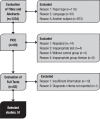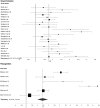Olfactory dysfunction in Alzheimer's disease Systematic review and meta-analysis
- PMID: 29988355
- PMCID: PMC6022986
- DOI: 10.1590/1980-57642018dn12-020004
Olfactory dysfunction in Alzheimer's disease Systematic review and meta-analysis
Abstract
Alzheimer's disease (AD), a neurodegenerative condition, is one of the most prevalent kinds of dementia, whose frequency doubles for every 5 years of age in elderly.
Objective: To determine the correlation between AD and olfactory alterations, identifying the most affected domains and exploring the utility of olfactory tests for complementing early diagnosis.
Methods: Databases were searched using the terms "olfactory OR smell OR olfaction AND alzheimer" for articles related to the proposed theme. The selected studies were categorized and evaluated separately depending on the method of analysis of the olfactory tests: identification of odors, discrimination and recognition, and a meta-analysis was carried out.
Results: Fifty-one articles were selected for analysis. The effect size for most studies was large, as were the summary values for each category of individualized olfactory analysis.
Conclusion: Among the olfactory domains, except memory, identification appears to be the most altered in AD. The possibility of including tests that specifically evaluate the identification of odors as an item in early diagnostic evaluation should be explored. PROSPERO registration: CRD42018089076.
Neurodegenerativa, a doença de Alzheimer (DA) é um dos tipos mais prevalentes de demência, com frequência dobrando a cada 5 anos em idosos.
Objetivo: Verificar a correlação entre DA e alterações olfatórias, identificando os domínios mais afetados e a possibilidade de utilização de testes olfatórios como complemento de diagnóstico precoce.
Métodos: Bases de dados foram acessadas utilizando os termos “olfactory OR smell OR olfaction AND alzheimer” buscando artigos relacionados ao tema proposto. Os estudos selecionados foram categorizados e avaliados em separado a depender do método de análise olfatória: identificação de odores, discriminação e reconhecimento e uma meta-análise foi realizada.
Resultados: Cinquenta e um artigos foram selecionado para análise. O tamanho do efeito da maioria dos estudos foi grande, assim como os valores sumários de cada categoria de análise olfatória.
Conclusão: Entre os domínios olfatórios, excetuando memória, a identificação parece ser a mais alterada em DA. É possível explorar a possibilidade de adição de testes específico para avaliação de identificação de odores como um item na avaliação diagnóstica precoce. Registro PROSPERO: CRD42018089076.
Keywords: Alzheimer’s disease; dementia; early diagnosis; olfactory disorders.
Conflict of interest statement
Disclosure: The authors report no conflicts of interest.
Figures
References
-
- Snowdon D, Greiner LH, Mortimer JA, Riley KP, Greiner PA, Markesbery WR. Brain infarction and the clinical expression of Alzheimer disease -The Nun Study. JAMA. 1997;227:813–817. - PubMed
-
- Doty RL, Perl DP, Steele JC, Chen KM, Pierce JD, Jr, Reyes P, et al. Odor identification deficit of the parkinsonism-dementia complex of Guam: equivalence to that of Alzheimer's and idiopathic Parkinson's disease. Neurology. 1991;41(2):77–80. - PubMed
-
- Igarashi KM, Lu L, Colgin LL, Moser MB, Moser EI. Coordination of entorhinal-hippocampal ensemble activity during associative learning. Nature. 2014;510:143–147. - PubMed
-
- Kim JY, Rasheed A, Yoo SJ, Kim SY, Cho B, Son G, et al. Distinct amyloid precursor protein processing machineries of the olfactory system. Biochem Biophys Res Commun. 2018;495(1):533–538. - PubMed
LinkOut - more resources
Full Text Sources
Other Literature Sources




